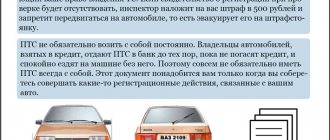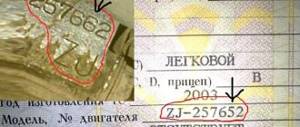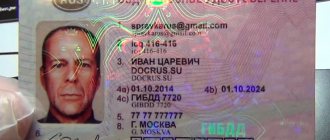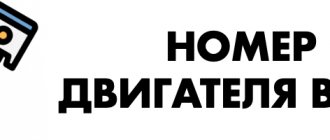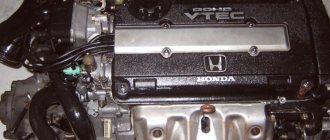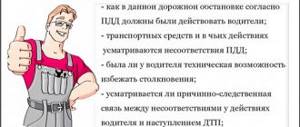Why it might be needed
Abroad, the engine model by VIN code has never been considered important. In the West, the engine is a replaceable part, so its number is used only for maintenance. It is not included in documents and is mainly of interest only to car service specialists.
In Russia and the countries of the former CIS, until 2011, information about the power plant allowed the inspection to identify entire fraudulent schemes. In our country, the engine identifier was necessarily entered into the PTS. Along with the body model, it was used to identify vehicles. This made it easier to investigate cases of theft. In addition, if the engine and body codes did not match, one could judge that the design of the car had changed.
In 2011, they tried to improve the situation with unit numbers by adopting Western experience, that is, the VIN ceases to play an important role, and its entry in the registration papers is canceled. Now the traffic police cannot refuse the owner to register a technical vehicle due to the absence or even mismatch of the VIN code.
What did it give? In the Moscow region alone, a large number of refusals were registered when attempting to register a car without an engine number. And one can only imagine what traffic police officers did in remote areas of our country. The problem of unit numbers has become one of the most confusing and complex situations. As always, the best practices of Western countries were aggravated by two common legal blunders in our country: the tendency of the executive branch to interpret new legislation in its own way, vaguely and ambiguously, and a strong exaggeration by the masses of the permitted provisions.
The abolition of the mandatory reconciliation of unit numbers immediately solved the problems for owners of cars with unreadable wine, of which, according to former official Shevtsov, there were almost 95%. But on the other hand, this same provision simplified the registration procedure and activated shadow and fraudulent schemes for the sale of contract engines.
Therefore, in 2013, by the next order of the Ministry of Internal Affairs, the previous wording about the unnecessaryness of reconciling the number was canceled. Now it has been clearly stated that the inspector has the right to completely refuse registration if the body number and internal combustion engine number differ.
Therefore, today it is important that the internal combustion engine matches the original car model. The following data must be encrypted in the VIN code:
- year of issue;
- body number;
- engine data;
- information about the car model, manufacturer and exporting country.
The engine code is required not only to simplify various legal procedures related to the traffic police. At the first breakdown of a used car, there will be a need to select original parts. Without knowing the engine model, this will be extremely difficult to do.
Thus, the owner needs engine marking in order to:
- determine the “cleanliness” of the car;
- find out the actual power of the internal combustion engine, modification and other technical information.
And also in order to avoid problems with the traffic police during re-registration.
Where is the Engine Number ZMZ 409?
UAZ cars are equipped with a four-cylinder, four-stroke ZMZ-409.10 engine with overhead camshafts and liquid cooling. The ZMZ-409.10 engine is equipped with a distributed fuel injection system and a microprocessor ignition system. Cylinder block
cast from gray cast iron. Between the cylinders there are channels for coolant. The cylinders are bored directly into the block body. The cylinder block has special bosses, flanges and holes for fastening parts, assemblies and assemblies, as well as channels for the main oil line.
The third bearing cover (assembled with the cylinder block) is machined at the ends to install two thrust steel-aluminum half-rings that limit axial movement crankshaft
.
A chain cover and an oil seal holder with crankshaft seals are bolted to the ends of the cylinder block. The oil sump is attached to the bottom of the cylinder block. The cylinder head
is cast from aluminum alloy. It contains intake and exhaust valves. There are four valves per cylinder: two intake and two exhaust. The inlet valves are located on the right side of the cylinder head, and the exhaust valves on the left. The valves are driven by two camshafts through hydraulic pushers. The use of hydraulic pushers eliminates the need to adjust the gaps in the valve drive, since they automatically compensate for the gap between the camshaft cams and the valve stems. The valve seats and valve guides are installed in the cylinder head with high interference.
The covers are processed together with the block head, so they cannot be swapped. All covers, except the front one, have serial numbers stamped on them.
Engine for Gazelle ZMZ 405 EURO-3 (40524.1000400)
Engine
for Gazelle
ZMZ
405 (40524.1000400) EURO-3.
In factory configuration. The price for the ZMZ
40524 EURO-3 engine ...
The cams are offset by 1.0 mm relative to the axis of the hydraulic pushers, which causes the hydraulic pushers to rotate when the engine is running. This reduces wear on the surface of the hydraulic pusher and makes it more uniform. On top of the cylinder head is closed with a cover cast from an aluminum alloy. Pistons
also cast from aluminum alloy. On the bottom of the piston there are four recesses for the valves, which prevent the piston from hitting the valves when the valve timing is disrupted. To ensure proper installation of the piston into the cylinder, the inscription “Front” is cast on the side wall near the boss under the piston pin. The piston is installed in the cylinder so that this inscription faces the front of the engine. Each piston has two compression rings and one oil scraper ring. Compression rings are cast from cast iron. The barrel-shaped working surface of the upper ring is covered with a layer of porous chrome, which improves the running-in of the ring. The working surface of the lower ring is covered with a layer of tin.
The pin is kept from moving in the axial direction by two spring retaining rings, which are installed in the grooves of the piston bosses. Connecting rods
steel, forged, with an I-section rod.
A bronze bushing is pressed into the upper head of the connecting rod. The lower head of the connecting rod is equipped with a cover attached with two bolts. The nuts of the connecting rod bolts have self-locking threads and are not additionally locked. The connecting rod caps are machined together with the connecting rod, so they cannot be moved from one connecting rod to another. The numbers of the corresponding cylinders are stamped on the connecting rods and their covers. To cool the piston bottom with oil, holes are made in the rod and the upper head of the connecting rod. Thin-walled liners are installed in the lower head of the connecting rod. The crankshaft
is cast from high-strength cast iron. The shaft has eight counterweights. It is kept from axial movement by thrust half-rings installed on the middle journal. A flywheel is attached to the rear end of the crankshaft, into the hole of which a spacer sleeve and a toe bearing of the gearbox input shaft are inserted. The water pump pulley is driven into rotation together with the generator pulley by a poly-V belt from the crankshaft pulley.
What the code looks like
The accessory number looks different depending on the specific car manufacturer. For example, the famous German concern Mercedes-Benz writes a code starting with the letters OM and the following three numbers. Volkswagen does the same, but instead of the letters OM it indicates EA.
The engine number can be other alphanumeric or simply digital indices. First, the year of manufacture is indicated, then the modification of the engine and at the end - data on climate adaptation.
Aggregate identifier VAZ 2112
Information about the engine is placed in the VIN - this is the serial code of the vehicle, which carries information about all components. Vin requires detailed decoding.
Interesting. On VAZ models before 1987, unit numbers containing a letter of the Latin alphabet were indicated, which indicated the year of manufacture. However, after claims from Europeans who confused the Latin alphabet with a modification of the main engine, on export analogues of the Zhiguli, the engine code contained only numbers. But for the domestic market, the so-called “letter” engines were still produced for some time.
Where is the car engine number located?
Finding the engine number can take a lot of time, especially on foreign cars. Due to the fact that Western concerns do not attach much importance to the VIN, it can be placed in various places, including those not protected from external negative influences. Therefore, often the aggregate identifier fades or disappears completely under the influence of precipitation.
On the engine itself
There are several common areas on the engine where the engine number is located:
- in the most visible place of the power plant - its upper part;
- on or near the cylinder block;
- on the left side of the unit;
- on the hole for the oil level dipstick;
- on the air intake;
- on the intake manifold;
- on the coolant radiator pipe;
- on the eye of the engine suspension;
- at the point of contact between the internal combustion engine and the gearbox.
The identifier is simply stamped by the manufacturer on a certain part of the engine, without a plate. Over time, such a code quickly fades, fades, and it can be very difficult to distinguish the numbers on it. For an effective search, it is recommended to organize preparatory activities - arm yourself with a flashlight, rust remover, and gloves. In some cases, you may need a mirror on the handle to be able to read the inscription marked on the reverse sides of the internal combustion engine.
On the plate under the hood
Some automakers additionally indicate the unit identifier on a metal plate, which is fixed with rivets or soldered under the hood of the car. For example, Volkswagen does this on the panel above the radiator. On some modifications of Audi and Volkswagen, the code plate is located on the engine valve cover or cylinder head.
Mercedes-Benz wine plate
Also, the identifier, in addition to the hood, can be located in an aluminum VIN plate knocked out inside the glove compartment, on the doorway, timing belt cover and other places.
Where is the engine number located?
There are a large number of options for the location of the engine number. Since the place where to look for the engine number may be in a very hard-to-reach part of the part, it is better to first find out the exact location of the code.
Most often, numbers are knocked out in such places.
- Near the cylinder block. This location is the most common and is found in approximately 30% of car models
- On the belt cover.
- On the bottom panel. Often found on American cars, including Ford. To view, you must use a mirror with a long handle.
- On the air intake.
- On the intake manifold.
- On the eye of the engine suspension.
There is a lot of space on the engine, so some manufacturers put the engine number in the most unexpected nooks and crannies (dipstick for checking the oil level or radiator pipe for antifreeze). If you are not sure of a successful code search, then you need to look at the PTS, provided that it was issued before 2011. Since the engine gets dirty quite quickly, experienced car enthusiasts recommend keeping it constantly clean and washing it regularly.
Since the most common cars on Russian roads are domestic brands, it is necessary to consider in more detail how to find the engine number on VAZ cars of various models.
Although the vehicles are produced at the same plant, the location of the engine numbers is different for almost every model. If to view some numbers there is no need to dismantle parts, then to detect codes on other models it is necessary to remove the units or use a special mirror.
Where is the engine number on the VAZ-2107
In the VAZ-2107, the code is in an easily accessible place, so there is no need to dismantle any parts. The engine number can be found on the left side of the cylinder block. Another reference point in finding the code is the oil filter - the number is located almost next to it. To search for the code, it is better to first clean the motor of dirt and also wipe that area with a dry cloth.
Where is the engine number on the VAZ-2109
Models 2108, 2109 and 21099 have the same engine number arrangement. In order to see the code, you need to remove the air filter. If the code is needed to be checked against the passport, but there is no reason to rush, then it is better to do this simultaneously with replacing the part. The engine number is located next to the thermostat, which makes it easy to see after removing the air filter.
You may also be interested in detailed information about faults in the VAZ 2109 electrical circuit.
Explanation of the designation
The number is deciphered according to the international standard ISO 3779. Each VIN symbol symbolizes a specific characteristic of the car. Determining car parameters by VIN code is easy and simple.
WMI
Occupies 1-3 positions in the general VIN code. Indicates the world manufacturer index. Under the first sign there is often an indication of the country, under the second – the automaker and under the third sign – a division or branch of the company. Examples of WMI decryption are given in the table below.
VDS
A symbol describing the engine model and other characteristics of the vehicle. Occupies position 4-9 in VIN, consists of 6 characters. Japanese and American manufacturers almost always indicate a control mark in the last position of the code, confirming the authenticity of the marking.
VIS
Index part, the last combination of numbers and letters. Here the manufacturer marks the model year, assembly site, and serial number of the vehicle.
What to do if there is no number
Oxidative processes have a destructive effect on certain areas of the metal car body. Corrosion can completely or partially “destroy” the place where the manufacturer applied the engine code. When the unit identifier is barely visible, you can advise car owners to clean the surface of rust themselves. It is advisable to use not very strong concentrates so as not to damage the remaining inscription. Some people recommend using sandpaper, but this is prohibited! Then you can’t prove to the traffic police that the ID was erased due to natural reasons. If you don’t have special solvents on hand, you can moisten a rag in clean kerosene and wipe it off.
Is it possible to drive on public roads in Russia if you have lost your engine number or VIN, or is this subject to a fine? The law states that the operation of cars with problematic markings is permissible only in one case - the number plate is damaged as a result of natural wear and tear (corrosion). If the car has been repaired, the frame or body has been replaced, which is why the unit identifiers have disappeared, you need to inform the MREO, where they will conduct additional tests.
Rust has eaten away the engine code.
Even if the engine identifier is not listed anywhere, it should be in the traffic police database. However, before buying a used car, you need to carefully look for the VIN code or serial number. If they are not visible, it is better to refuse the purchase.
Engine number on popular car models
If we talk about cars of the German concern WAG, then on the Audi A3 produced in 2006-2008, the marker is located on the left side at the junction of the unit and the transmission; there is also a plate located on the valve cover. The popular 2001 A4 model has an internal combustion engine identifier on the left of the cylinder block and a similar plate on the cylinder head cover.
The 2001-04 Audi A6 received a similar engine number location, but the 2005-08 model has the number at the front of the cylinder block, which is covered by a casing. The diesel 3-liter TDI SUV Audi Q7 2007-08 has the unit number on the left side and slightly higher relative to the high-pressure fuel pump timing belt.
The common Volkswagen Golf of 2005-2009 has an engine marking on the left side, where the power unit and gearbox are connected, and there is also a duplicate sticker on the cylinder head cover. The situation is similar with the 2005-08 VW Jetta, as well as with the 2000-08 Passat. The engine number of these cars is also on the left of the cylinder block, and there is a special number plate on the cover.
The 2003-07 Touareg SUV with a 3.2 engine received the unit number on the cylinder block near the torsional vibration damper. Diesel versions of the model with 2.5 TDI engines of 2003-09 are marked at the junction of the internal combustion engine with the gearbox, and 3-liter versions of 2006-10 received the engine number in the front left, located above the timing belt of the fuel pump.
Compact Skoda Fabia with a displacement of 1.2 liters. 2004-08 has an internal combustion engine number on the BC at the junction of the engine and gearbox, and the popular Skoda Octavia is marked on the left side of the power unit, closer to the battery.
The Korean division of GM, which produces budget cars under the Chevrolet brand, has a different location for the power unit designation on different models. On Chevrolet Aveo and Lanos, the number is located slightly to the right of the location of the dipstick for checking the oil level. On a Chevrolet Lacetti, the engine number is printed on the cylinder block, below the intake manifold.
Now let's take a look at the South Korean auto giant Hyundai/Kia. On the Hyundai Solaris model, the engine number is made on the front wall on the BC protrusion under the filler neck for pouring liquid into the engine cooling system. The Santa Fe SUV has a unit designation at the junction of the internal combustion engine and gearbox. On the Kia Rio, the engine number is similar to the Hyundai Solaris.
Table: where and how the engine number is located on famous foreign cars
| Car make and modification | Code location without sign | Location of the code in the form of a plate |
| Audi A3 2006-2008 | On the left side of the internal combustion engine, at the junction of the unit and transmission | On the valve cover, the timing belt guard, as well as on the service plan and the spare wheel chute. |
| Audi A4 2001 | The engine identification number is stamped on the left side of the cylinder block at the junction of the engine and gearbox. For a diesel engine, the engine number is located between the high pressure fuel pump and the vacuum pump. | The engine identification number is also printed on a sticker on the timing belt cover. In addition, the engine identification code is located on the vehicle data plate located in the spare wheel well or on the bottom of the luggage compartment and is listed in the service book. |
| Audi A4 2005-08 | The engine identification number is stamped on the inside of the right cylinder block between the cylinder head and the hydraulic pump (diesel engine: between the cylinder head and the high pressure fuel pump). | On the toothed belt cover, in the VIN code, niche for the spare wheel, bottom of the trunk. |
| Audi Q7 2007-08 diesel TDI 3 l | On the left side of the engine and slightly above the injection pump timing belt | |
| Volkswagen Golf 2005-2009, Jetta 2005-08 | At the junction of the power unit and gearbox | On the cylinder head cover |
| Volkswagen Passat B5 2000-2005 | The engine number (engine letter and serial number) is located on the left of the cylinder block. | Additionally, a plate with the engine letter and serial number is applied to the cylinder head cover. |
| Volkswagen Golf 2006-2009, Jetta 2006-2008 | Located on the left at the junction of the engine and gearbox | On the cylinder head |
| Volkswagen Transporter 2.5TDI 2004-2009 | At the engine/gearbox interface | On the cylinder head |
| Volkswagen Touareg 2003-07 3.2 l | On the cylinder block near the vibration damper | |
| Volkswagen Touareg 2.5 TDI 2003-09 | At the junction of the internal combustion engine and the gearbox | |
| Volkswagen Touareg 3 l 2006-10 | In the front part of the engine installation on the left, located above the timing belt of the fuel pump | |
| Skoda Fabia 1.2 l. 2004-08 | On the left front on the engine block at the dividing butt seam between the internal combustion engine and the gearbox | On the timing gear cover |
| Skoda Octavia | On the left side of the power unit, closer to the battery | Right front fender strip (VIN), under the windshield, under the floor in the trunk |
| Chevrolet Aveo, Lanos | Slightly to the right of the location of the dipstick for checking the oil level | |
| Chevrolet Lacetti | On the cylinder block, below the intake manifold, (VIN) is stamped at the top of the bulkhead | The Vehicle Identification Number (VIN) plate is attached to the top of the dash pillar |
| Ford Focus | Number panel in the area where the engine and gearbox connect | |
| Ford Mondeo | Behind the engine, closer to the driver's seat | On the driver's side, above the engine, between the internal combustion engine and the interior wall, closer to the driver's side |
| Ford Transit | Hidden in the front part of the internal combustion engine and located under the generator, packed on the block (vertical platform), near the right engine mount, when viewed in the direction of travel, on the vertical platform of the cylinder head at the front end | |
| Hyundai Solaris, Kia Rio | On the front wall-protrusion of the BC, under the filler neck for pouring liquid into the cooling system | |
| Hyundai Santa Fe | At the junction of the engine and gearbox | |
| Toyota Land Cruiser Prado | In the wheel arch, covered with a curtain |
Where is the engine number on popular cars?
To make it clearer where exactly to look for information about the engine number, here are a few examples of where manufacturers post the relevant information:
On VAZ cars, for example, VAZ-2110, the engine number is located on the cylinder block under the thermostat housing. To examine it, you will need to remove the air filter housing to the side;- On Audi A3 cars, the engine number is located in a rather unusual place - at the junction of the engine and transmission. Also on the engine valve cover itself there is an information plate with a number;
- On Audi A4 cars from the early 2000s, the engine number is located on the left side of the cylinder block or on the cylinder head cover;
- On Audi Q7 vehicles with a TDI diesel engine, the number is located above the timing belt of the high-pressure fuel pump;
- On Volkswagen Golf, Passat, Jetta cars, the engine number is often placed at the junction of the engine and gearbox, and it is also duplicated on the cylinder head cover (most often in the form of a sticker, so it may not be there, especially if the car is old);
- On Volkswagen Touareg vehicles, the engine number should be found near the vibration damper on the cylinder block;
- On Skoda Fabia cars, the engine number is located near the connection between the engine and gearbox. It also happens in the Skoda Octavia, but if it is not there, then you should look on the left side of the cylinder block near the battery;
- On Chevrolet Lanos and Aveo cars, the car's engine number is most often located near the dipstick for checking the oil level;
- On Hyundai and Kia cars of different models, the engine number is located on the protrusion of the cylinder block under the antifreeze fill area.
Listed above are the most common engine number locations on popular car models. It is worth noting that some car manufacturers also use unusual places to indicate engine information. For example, on Land Cruiser vehicles the engine number may be located in the wheel arch.
( 106 votes, average: 4.50 out of 5)
How to clean the lenses in your headlights
How to clean the car interior from cat or dog hair
Related Posts
Table: decoding of the WMI designation of foreign cars assembled in the Russian Federation
| WMI | Brand and manufacturer |
| X4A | BMW, Avtotor (Kaliningrad) |
| X4X | CHERY, Avtotor (Kaliningrad) |
| XUV | CHERY, TagAZ (RUS) |
| X9L | CHEVROLET, GM-AvtoVAZ JV |
| XUF | CHEVROLET, LLC General Motors Avto (RU) |
| XUU | CHEVROLET, Avtotor (Kaliningrad) |
| Z8T | CITROEN, PCMA Rus (RUS) |
| Z8N | DATSUN, Nissan Manufacturing Rus LLC (RUS) |
| XU3 | FIAT, Sollers-Naberezhnye Chelny OJSC (RUS) |
| Z76, Z7G | FIAT, Sollers-Elabuga LLC (RUS) |
| WF0, X4F, X9F | FORD, LLC Ford Motor Company (RU) |
| X91 | GEELY, AMUR |
| X4X | HUMMER, Avtotor (Kaliningrad) |
| X7M | HYUNDAI, TagAZ (RUS) |
| Z94 | HYUNDAI, HYUNDAI MOTOR MANUFACTURING RUS LLC (RUS) |
| X91 | ISUZU, AMUR |
| XTK | KIA, Izhmash JSC |
| X89 | MERCEDES-BENZ, EvoBus Russland LLC (RUS) |
| XDN | MERCEDES-BENZ, GAZ OJSC (RUS) |
| Z8T | MITSUBISHI, PCMA Rus (RUS) |
| Z8N | NISSAN, Nissan Manufacturing Rus LLC (RUS) |
| XUF | OPEL, LLC General Motors Avto (RU) |
| Z8T | PEUGEOT, PCMA Rus (RUS) |
| X9P | RENAULT, Volvo Vostok JSC (RU) |
| XW8 | SKODA, Volkswagen Group Rus (LLC) (RU) |
| Z8U | SSANG YONG, Sollers-Far East LLC (RUS) |
| XW7 | TOYOTA, Toyota Motor Manufacturing Russia LLC (RUS) |
| XW8 | VOLKSWAGEN, Volkswagen Group Rus (LLC) (RU) |
Table: examples of decoding VIN codes of famous foreign cars
| VIN | Decoding |
| 4USBT53544LT26841 | BMW E85 (Z4) Z4 3.0i M54, roadster - 2 doors, Dingolfing, Germany |
| KL1UF756E6B195928 | CHEVROLET Rezzo/Tacuma 1.6, minivan - 5 doors, petrol manual transmission, 2006 Bupiyong |
| ZFA18800004473122 | FIAT, Punto 80 ELX 188AXB1A, hatchback - 3 doors, 188A5.000 (1242 cc / 80 hp) March 2002 |
| JHLRE48577C415490 | HONDA CR-V 2.4 RVSi K24Z1 (2400 DOHC VTEC), MZHA (automatic - 5speed), 2007 |
| KMHBT31GP3U013758 | HYUNDAI Getz GL 1.1 l, manual - 5 speed, November 2002, manufactured by UI-San (Korea) for sale in Germany |
| KNDJC733545301768 | KIA Sorento GL 4WD EB / FC 3.5l (MPI-DOHC), automatic. - 4th century, April 2004 for sale in the USA |
| SALFA28B57H011265 | LAND-ROVER Freelander II 2.2 TD4 diesel/2179 cc/152 hp (DOHC/EFI), mechanical - 6th grade, January 2007 |
| JMZGG128241207606 | MAZDA 6 27C / GH7 petrol - 1800 cc, 5MT, September 2003. |
| 4JGBF71E47A278782 | MERCEDES-BENZ GL 450 4Matic 273923, box 722904, May 2007, assembled Sindelfingen (Germany)/Vance, Alabama, USA |
| JA4LX31G93U065670 | MITSUBISHI Outlander M-Line 2WD CU4W(QRMEL2M) 2400 ccm, automatic transmission - 4 speed, November 2002, 3rd decade |
| JN1TBNT30U0124100 | NISSAN T30 X-Trail Sport QR25DE (petrol - 2.5l), Automatic gearbox, May 2006. |
| WP1AB29P66LA68044 | PORSCHE CAYENNE S M48.00 [4.50L-250Kw], 2006 |
| VF1LB0K0525551701 | RENAULT Clio II K4J [B/1390 ccm/70kW], gearbox JB3/DP0 |
| JF1GGGKD37G038841 | SUBARU Impreza (G11) WRX 4WD 255 [2500CC EMPI DOHC TURBO], manual. — 5th century, February 2007 |
| JT111TJ8007010945 | TOYOTA Land Cruiser HDJ80 1HDT [4200cc - diesel turbo], October 1992. |
If you have any questions, leave them in the comments below the article. We or our visitors will be happy to answer them
